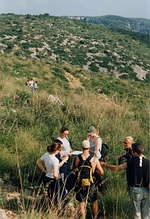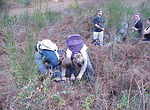Soil Catenas
A soil catena is a sequence of different soil profiles that occur down a slope. They occur on hill slopes where the geology is uniform and there is no marked difference in climate from the top to the bottom of the slope. This makes the slopes of the Garraf Natural Park an ideal location to study such a catena, as the underlying rock type is limestone and the climate relatively constant.
The variations in soil profile that occur down the slope are largely the result of changes in slope gradient. Soil can be eroded easily from a steep slope, but will tend to accumulate on shallower gradients. Soil water will drain freely on steep slopes, but will take much longer to drain from shallower ones. Soil drainage is relatively important in the formation of the catena on the Garraf as although the limestone bedrock is permeable, the permeability is reduced by soil accumulation and the steep gradients encourage movement downslope rather than through the soil. This means that many nutrients are washed downslope, along with small particles. This has an effect on the texture and pH of the soil. This affects the properties of the soil.
|
During the field investigation stage, it is important to establish an understanding of the process operating within the soil.
- The depth of organic matter can be linked readily with cycling efficiency, wetness, temperature and acidity by analysing its structure.
- Red and grey colours can be used to indicate the oxidation status.
- Moderate precipitation can be sufficient to leach away any calcium carbonate which dissolves from the hard limestone fragments and thus maintain an acid soil reaction. In this acid medium the dissociation of the clay minerals can begin and is normally evidenced by the red coloration of the ferric oxide (Fe2O3) so released. Because of this, these soils are referred to as 'terra rossa' or 'red limestone' soils.
- Leaching processes can be deduced from accumulation lower down in the soil profile and they can also be predicted to occur from accumulations of organic matter on the top of the profile because these act as sources of organic acids.
AIMS
1. To examine the characteristics of a soil catena on the Garraf.
2. To make a comparison of the catenas on the West, East and South-facing slopes of the Garraf.
|
3. To understand the processes that operate within a soil and lead to its
development.
4. To look for evidence that suggests human activity (in this case historic land
use) is dependent on soil quality.
5. To look for evidence that people have attempted to improve the soil quality
or prevent its further deterioration.
HYPOTHESES
1. Soil characteristics on the West and East and South-facing slopes of the
Garraf will differ.
2. Soil depth will decrease as gradient increases.
3. Soil moisture will decrease as gradient increases
4. Soil acidity will be highest where gradient is lowest and leaching
predominates. Terra Rossa soils will be found in these locations.
5. Soil texture will be sandier where slope gradient is greatest and clay
particles have been washed down-slope.
6. Organic content will be highest where slope gradient is lowest and soil depth
greatest.
7. Soil acidity will be positively related to vegetation density.
8. Human activity is influenced by soil quality.
9. Humans have attempted to improve the soil quality or prevent its further
deterioration.


